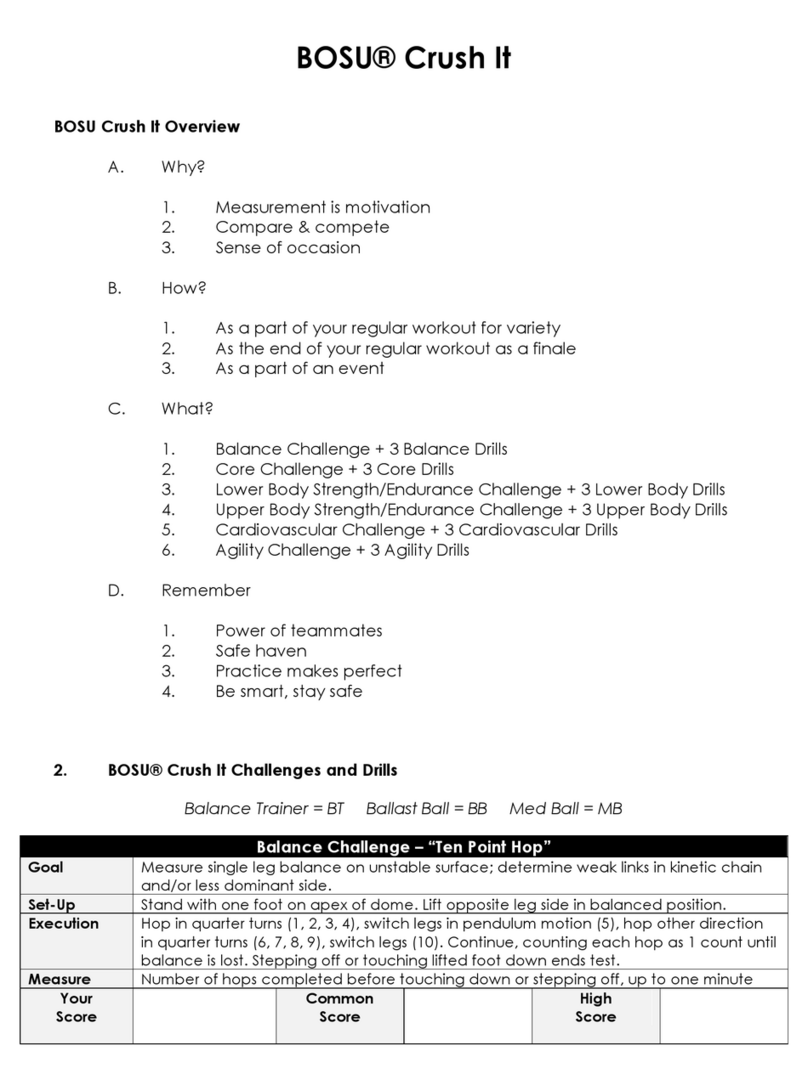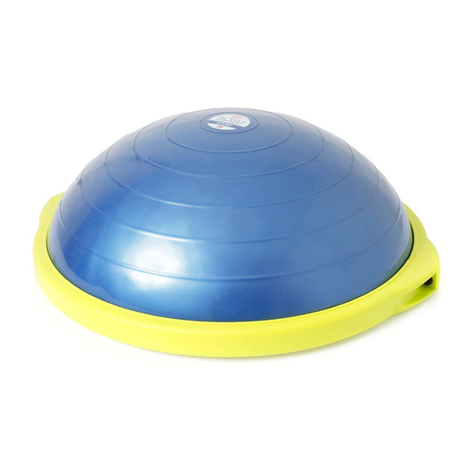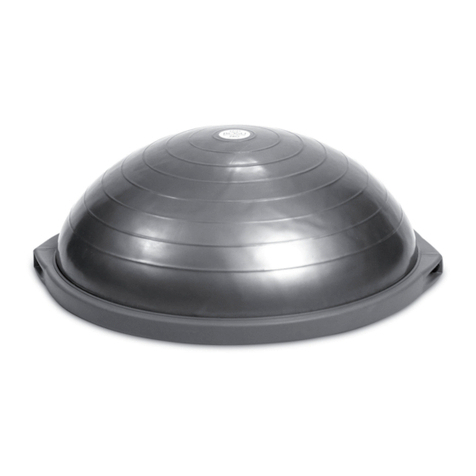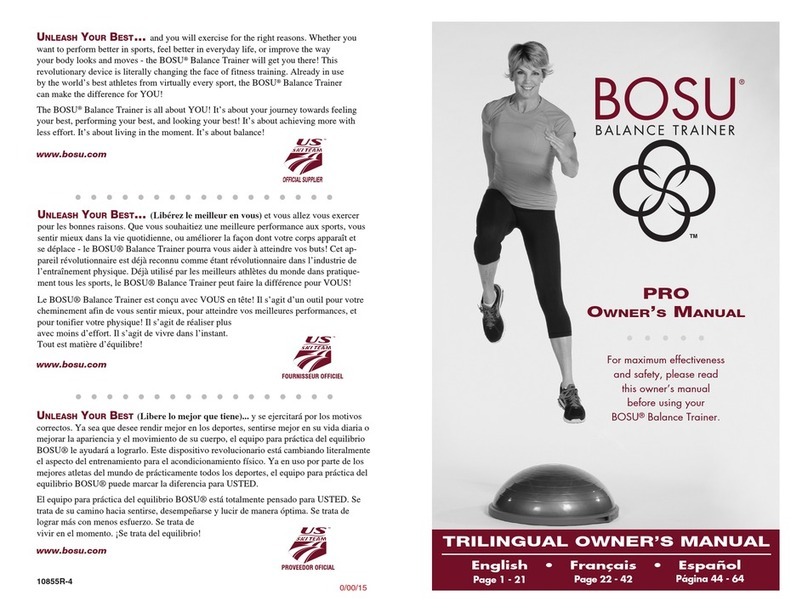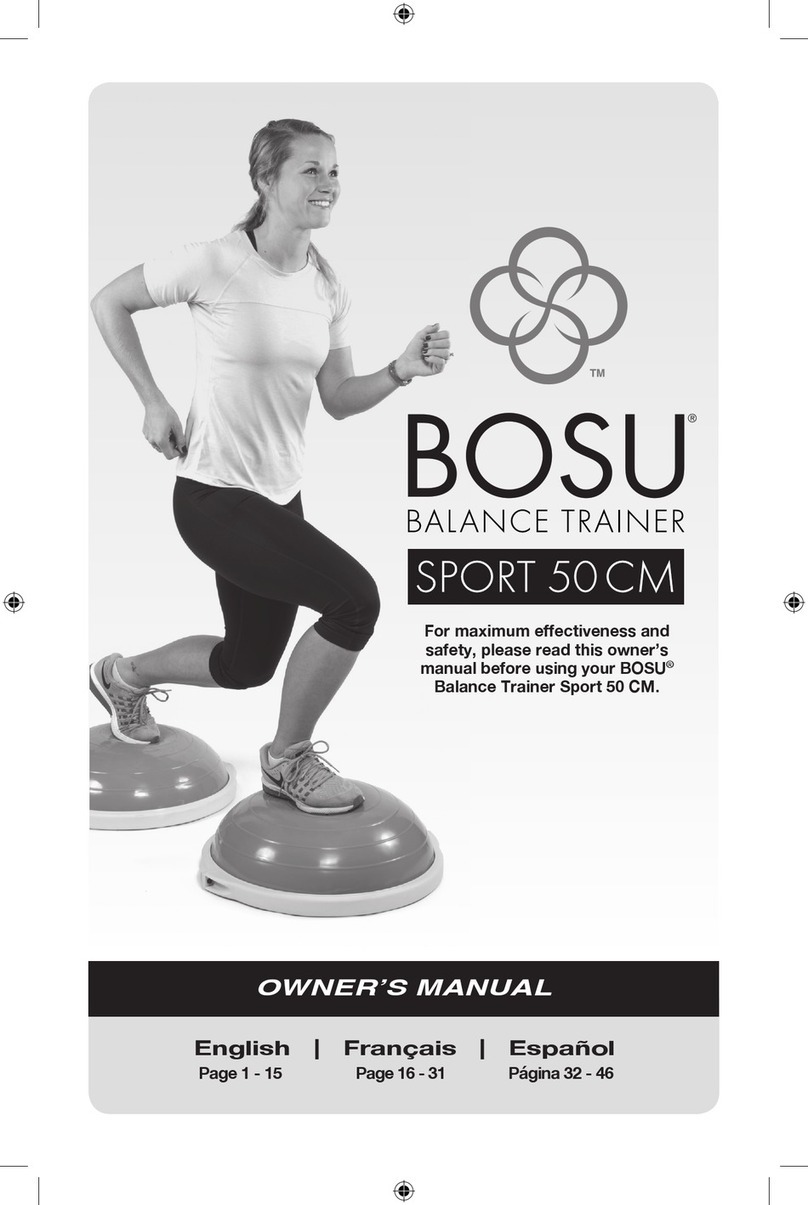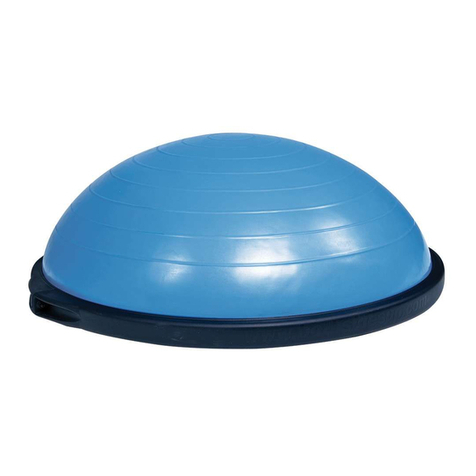BOSU NEXGEN User manual

Le BOSU® Balance Trainer est conçu avec VOUS en tête! Il s’agit d’un outil pour votre
cheminement afin de vous sentir mieux, pour atteindre vos meilleures performances, et
pour tonifier votre physique! Il s’agit de réaliser plus
avec moins d’effort. Il s’agit de vivre dans l’instant.
Tout est matière d’équilibre!
UNLEASH YOUR BEST (Libere lo mejor que tiene)... y se ejercitará por los motivos
correctos. Ya sea que desee rendir mejor en los deportes, sentirse mejor en su vida diaria o
mejorar la apariencia y el movimiento de su cuerpo, el equipo para práctica del equilibrio
BOSU® le ayudará a lograrlo. Este dispositivo revolucionario está cambiando literalmente
el aspecto del entrenamiento para el acondicionamiento físico. Ya en uso por parte de los
mejores atletas del mundo de prácticamente todos los deportes, el equipo para práctica del
equilibrio BOSU® puede marcar la diferencia para USTED.
El equipo para práctica del equilibrio BOSU® está totalmente pensado para USTED. Se
trata de su camino hacia sentirse, desempeñarse y lucir de manera óptima. Se trata de
lograr más con menos esfuerzo. Se trata de
vivir en el momento. ¡Se trata del equilibrio!
PROVEEDOR OFICIAL
UNLEASH YOUR BEST... (Libérez le meilleur en vous) et vous allez vous exercer
pour les bonnes raisons. Que vous souhaitiez une meilleure performance aux sports,
vous sentir mieux dans la vie quotidienne, ou améliorer la façon dont votre corps
apparaît et se déplace - le BOSU® Balance Trainer pourra vous aider à atteindre vos
buts! Cet appareil révolutionnaire est déjà reconnu comme étant révolutionnaire dans
l’industrie de l’entraînement physique. Déjà utilisé par les meilleurs athlètes du monde
dans pratiquement tous les sports, le BOSU® Balance Trainer peut faire la différence
pour VOUS!
www.bosu.com
www.bosu.com
UNLEASH YOUR BEST... and you will exercise for the right reasons. Whether you
want to perform better in sports, feel better in everyday life or improve the way
your body looks and moves - the BOSU®Balance Trainer will get you there! This
revolutionary device is literally changing the face of fitness training. Already in use
by the world’s best athletes from virtually every sport, the BOSU®Balance Trainer
can make the difference for YOU!
The BOSU®Balance Trainer is all about YOU! It’s about your journey towards feeling
your best, performing your best and looking your best! It’s about achieving more with
less effort. It’s about living in the moment. It’s about balance!
www.bosu.com
10855R-5NG For maximum effectiveness and safety, please read this owner’s manual before using
your BOSU®Balance Trainer NexGen™.
NEXGEN™
Owner’s Manual
TRILINGUAL OWNER’S MANUAL
English • Français • Español
Page 1 - 19 Página 40-58
Page 20-39
FOURNISSEUR OFFICIEL

1

©BOSU®Fitness, LLC. All rights reserved. BOSU® and BOSU®logo are trademarks of BOSU®
Fitness, LLC. U.S. Patent Nos. 6,422,983, 6,575,885, 6,554,753, 7,344,488 and 7,494,446.
No part of this booklet may be reproduced or utilized in any form or by any means electronic,
mechanical or otherwise without the express written consent of the copyright holder.
TABLE OF CONTENTS
Important Safety Tips ................................................... 3-4
Equipment Warning Labels ..............................................5
Specifications & Parts.......................................................6
Introduction.......................................................................7
A Message From The Inventor .........................................8
Care & Storage..................................................................9
Getting Started ................................................................10
General Exercise Guidelines...........................................11
The BOSU®Balance Trainer Workout..................... 12-17
Your Total Fitness Program............................................18
Limited Warranty............................................................19
2

3
IMPORTANT SAFETY TIPS
1) Before starting this or any other exercise program, consult your physician. Your physician
should assist you in determining the target heart rate zone appropriate for your age and physical
condition. Your physician can also help you determine if you have physical limitations that
could create a health risk or prevent you from properly using this equipment. Certain exercise
programs or types of equipment may not be appropriate for all people. This is especially
important for people over the age of 35, pregnant women, or those with pre-existing health
problems, orthopedic conditions, or balance impairments. If you are taking medication
which may affect your heart rate, a physician’s advice is absolutely essential.
2) Handicapped or disabled people must have medical approval before using this equipment
and should be under close supervision when using any exercise equipment.
3) Do not overexert yourself with this or any other exercise program. Listen to your body
and respond to any reactions you may be having. You must learn to distinguish “good” pain,
like fatigue, from “bad” pain, which hurts. If you experience any pain or tightness in your
chest, an irregular heartbeat, dizziness, nausea, or shortness of breath, stop exercising
at once and consult your physician immediately.
4) Breathe naturally, never holding your breath during an exercise. Avoid over training, you
should be able to carry on a conversation while exercising.
5) Before each use, visually inspect the equipment. To help avoid unexpected sliding of the
BOSU®Balance Trainer, make sure all 6 feet are tightly inserted into the platform. Do not
use the equipment if any of the feet are missing. Never use the equipment if parts are
missing or if the equipment is not functioning properly.
6) Before each use, make sure the dome is properly inflated. Over-inflating the dome can
cause the dome to separate from the platform. Immediately stop using the equipment and
contact customer service if this occurs.
7) Wear appropriate clothing when exercising. Workout clothing should be comfortable,
lightweight and should allow freedom of movement. Wear comfortable athletic shoes made
of good support with non-slip soles, such as cross-training or aerobic shoes. For some exercises,
you may be instructed to exercise in your bare feet. Never exercise in socks, stockings, etc.
8) Use this equipment only for the intended use as described by the manufacturer. Do not
modify the equipment or use attachments not recommended by the manufacturer.
9) Follow the exercise technique guidelines in this manual and when following any of the
BOSU®exercise videos. Correct exercise technique will help you get the results you want
and keep you exercising safely. Do not use your BOSU®Balance Trainer until you have
read this manual completely.
WARNING
FAILURE TO READ AND FOLLOW THE SAFETY INSTRUCTIONS STATED ON
THE EQUIPMENT, IN THIS OWNER’S MANUAL AND VIDEO(S) MAY RESULT IN
POSSIBLE SERIOUS INJURY OR DEATH.

4
10) Start out slowly and progress sensibly. Before beginning any workouts, become acclimated
with the dynamic surface of the BOSU®Balance Trainer by slowly stepping on and off the
dome, practicing the “centered” position, etc. Once you become acclimated, start with the
beginner workout and become familiar with all of the exercises before moving on to more
advanced workouts or exercises.
11) The dynamic surface of the BOSU®Balance Trainer can enhance fitness training in a number
of ways but it is important to remember that it is still highly unstable and the potential for a
fall that may result in injury does exist. Move slowly and with control throughout the workout.
To reduce the likelihood of a fall, simply step off of the BOSU®Balance Trainer safely
to the floor if you feel that you are losing your balance at anytime.
12) Standing on platform is not recommended. It is an advanced exercise that increases the
risk of a fall resulting in SERIOUS INJURY OR DEATH.
13) Make sure the BOSU®Balance Trainer is set on a non-slip, level surface with adequate
clearance space around you. You should have enough space to lie in a face up, face down,
or sidelying position on top of the dome, and to be able to step off safely in any direction.
Make sure that if you lost your balance and fell, you would not hit any nearby objects.
To reduce the risk of injury if a fall were to occur, use a mat or exercise pad on wood
or other hard surfaces.
14) Wipe sweat off the vinyl surface of the BOSU®Balance Trainer dome before each use
and while working out as needed. Not unlike a wet basketball floor, sweat will make the
dome surface slippery. Use a towel to wipe sweat off the dome if necessary. A dry BOSU®
Balance Trainer provides for a safer and more effective training environment.
15) Warm up before any exercise program by doing 5 to 10 minutes of gentle aerobic exercise,
such as walking, followed by stretching.
16) Cool down after an exercise session, with 5 to 10 minutes of gentle exercise, such as
walking, followed by stretching.
17) The BOSU®Balance Trainer is not a toy. Children must be supervised by an adult
familiar with the proper use of this product. To prevent injuries, keep this and all
fitness equipment out of the reach of unsupervised children. Follow these simple rules:
– Keep unsupervised children out of rooms where you have your exercise equipment.
– Store exercise equipment in a room that can be locked.
– Know exactly where your children are when you work out.
– If you have small children at home, don’t wear headphones while you work out.
– Talk to your kids about the dangers of exercise equipment.
18) When storing the BOSU®Balance Trainer, make sure the dome is not in direct contact
with any other surfaces. The dome needs to breathe to prevent sweating (i.e. an oily
residue may appear on the dome), which can cause the dome to be slippery increasing
the likelihood of a fall resulting in injury. If the dome does sweat, follow the cleaning
instructions on page 9.
Table of contents
Other BOSU Fitness Equipment manuals
Popular Fitness Equipment manuals by other brands

G-FITNESS
G-FITNESS AIR ROWER user manual

CAPITAL SPORTS
CAPITAL SPORTS Dominate Edition 10028796 manual

Martin System
Martin System TT4FK user guide

CIRCLE FITNESS
CIRCLE FITNESS E7 owner's manual

G-FITNESS
G-FITNESS TZ-6017 user manual

Accelerated Care Plus
Accelerated Care Plus OMNISTIM FX2 CYCLE/WALK user manual
